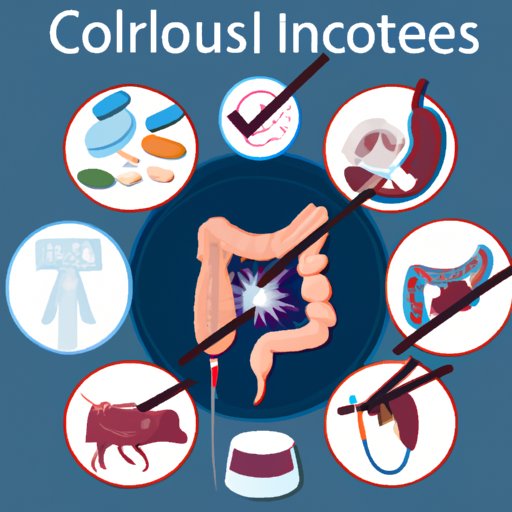
Introduction
Ulcerative colitis is a type of inflammatory bowel disease (IBD) that affects the colon and rectum. It can cause a range of symptoms that can be debilitating and impact overall quality of life. While the exact cause of ulcerative colitis is unknown, it is believed to be the result of an abnormal immune response in the digestive system. Early identification of ulcerative colitis symptoms is crucial in ensuring effective treatment and management of the disease. In this article, we will take a closer look at ulcerative colitis symptoms, diagnosis, treatment, and coping mechanisms.
A Comprehensive Guide on Ulcerative Colitis Symptoms That You Should Know
Ulcerative colitis symptoms can vary from person to person and can be mild to severe. Some of the most common symptoms of ulcerative colitis include:
Abdominal pain and cramping
Abdominal pain and cramping are common symptoms of ulcerative colitis and can range from mild discomfort to severe pain. This pain is typically caused by the inflammation in the colon and rectum, which can cause the muscles to contract more than usual.
Diarrhea
Diarrhea is one of the hallmark symptoms of ulcerative colitis. It is characterized by loose, watery stools that can occur several times a day. The diarrhea can be bloody or contain mucus, and it can last for several weeks or months.
Rectal bleeding
Rectal bleeding is another common symptom of ulcerative colitis. It is usually caused by inflammation in the rectum or lower part of the colon. The blood may be bright red or maroon in color and may be present in the stool or on the toilet paper.
Weigh loss and fatigue
Weight loss and fatigue can result from the body’s inability to absorb nutrients due to diarrhea and inflammation in the digestive system. In some cases, anemia may result from significant rectal bleeding, leading to chronic fatigue and weakness.
Fever and chills
A fever and chills can be a sign of more severe ulcerative colitis symptoms. It is typically indicative of an infection or inflammation in the colon or rectum. These symptoms require immediate medical attention.
Recognizing Ulcerative Colitis Symptoms: A Complete Overview
Diagnosing ulcerative colitis requires a thorough evaluation of the patient’s symptoms, medical history, and physical examination. In addition, several diagnostic tests are used to identify the disease, including:
Blood tests
Blood tests may be performed to detect elevated levels of inflammation in the body, which suggests ulcerative colitis or other digestive disorders.
Fecal tests
Fecal tests are typically used to rule out other gastrointestinal disorders such as infections or parasites. In some cases, fecal calprotectin levels may be high, indicating inflammation in the colon or rectum.
Colonoscopy
A colonoscopy is a procedure in which a thin, flexible tube with a camera on the end is inserted into the rectum to examine the entire colon. This test allows physicians to assess the severity and location of inflammation, assess the effectiveness of treatment, and detect the presence of precancerous cells.
The Telltale Signs of Ulcerative Colitis: Symptoms and Treatment
While ulcerative colitis cannot be cured, treatment options are available to manage symptoms and reduce inflammation. The most common treatment options include:
Anti-inflammatory medications
Anti-inflammatory medications such as mesalamine or sulfasalazine are often the first line of treatment for mild to moderate ulcerative colitis. These medications are typically taken in oral or rectal form and can reduce inflammation in the colon and rectum.
Immunosuppressive agents
Immunosuppressive agents such as azathioprine or methotrexate may be used to reduce inflammation by suppressing the immune system. These medications are typically reserved for more severe cases of ulcerative colitis or cases that are unresponsive to other treatments.
Surgery
In severe cases of ulcerative colitis, surgery may be necessary to remove the colon and rectum. This procedure is typically reserved for cases where medications are ineffective or when precancerous cells are present.
Living with Ulcerative Colitis: A Breakdown of the Symptoms and Coping Mechanisms
Living with ulcerative colitis can be challenging and impact daily life. Coping mechanisms can help alleviate some of the physical and emotional symptoms of the disease. Some strategies for managing ulcerative colitis include:
Dietary changes
A low-fat, low-fiber diet may help reduce symptoms of ulcerative colitis, such as diarrhea and abdominal cramping. Additionally, avoiding trigger foods that exacerbate symptoms can help improve overall quality of life.
Stress reduction techniques
Stress can exacerbate symptoms of ulcerative colitis. Engaging in activities such as yoga, meditation, or deep breathing exercises can help reduce stress levels and improve overall well-being.
Seeking support
Living with ulcerative colitis can be isolating. Joining a support group or speaking with a mental health professional can help alleviate some of the emotional burden associated with the disease.
Detecting Ulcerative Colitis Symptoms: Why Early Intervention Matters
Early identification of ulcerative colitis symptoms is crucial in preventing the disease from progressing and causing complications. If left untreated, ulcerative colitis can cause long-term damage to the colon and rectum, leading to an increased risk of colon cancer. Prompt medical attention and intervention can help prevent serious health complications and improve overall quality of life.
Conclusion
In summary, ulcerative colitis is a complex gastrointestinal disease that can significantly impact daily life. Identifying symptoms early and seeking prompt medical attention is crucial in ensuring effective treatment and management of the disease. Coping mechanisms can help alleviate the physical and emotional symptoms associated with the condition. If you or a loved one are experiencing symptoms of ulcerative colitis, it is important to seek medical attention immediately.





